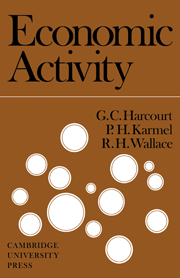Book contents
- Frontmatter
- Preface
- Contents
- 1 INTRODUCTION
- 2 THE NATIONAL ACCOUNTS AND THE INCOME–CREATION PROCESS
- 3 THE PRODUCTION–INCOME–EXPENDITURE CIRCUIT AND NATIONAL ACCOUNTING IDENTITIES
- 4 THE DETERMINATION OF THE EQUILIBRIUM LEVEL OF REAL INCOME
- 5 THE CONCEPT OF FULL EMPLOYMENT
- 6 MONEY IN THE ECONOMIC PROCESS
- 7 THE BANKING SYSTEM AND THE QUANTITY OF MONEY
- 8 THE CONSUMPTION FUNCTION
- 9 THE DETERMINANTS OF INVESTMENT EXPENDITURE
- 10 THE EFFECT OF CHANGES IN EXPENDITURE PLANS: THE MULTIPLIER CONCEPT
- 11 THE GOVERNMENT SECTOR AND THE DETERMINATION OF REAL INCOME
- 12 THE OPEN ECONOMY
- 13 THE INTERACTION BETWEEN PLANNED EXPENDITURES AND FINANCIAL FACTORS
- 14 INFLATION
- 15 ECONOMIC POLICY
- List of suggested reading
- Index
5 - THE CONCEPT OF FULL EMPLOYMENT
Published online by Cambridge University Press: 18 December 2009
- Frontmatter
- Preface
- Contents
- 1 INTRODUCTION
- 2 THE NATIONAL ACCOUNTS AND THE INCOME–CREATION PROCESS
- 3 THE PRODUCTION–INCOME–EXPENDITURE CIRCUIT AND NATIONAL ACCOUNTING IDENTITIES
- 4 THE DETERMINATION OF THE EQUILIBRIUM LEVEL OF REAL INCOME
- 5 THE CONCEPT OF FULL EMPLOYMENT
- 6 MONEY IN THE ECONOMIC PROCESS
- 7 THE BANKING SYSTEM AND THE QUANTITY OF MONEY
- 8 THE CONSUMPTION FUNCTION
- 9 THE DETERMINANTS OF INVESTMENT EXPENDITURE
- 10 THE EFFECT OF CHANGES IN EXPENDITURE PLANS: THE MULTIPLIER CONCEPT
- 11 THE GOVERNMENT SECTOR AND THE DETERMINATION OF REAL INCOME
- 12 THE OPEN ECONOMY
- 13 THE INTERACTION BETWEEN PLANNED EXPENDITURES AND FINANCIAL FACTORS
- 14 INFLATION
- 15 ECONOMIC POLICY
- List of suggested reading
- Index
Summary
The preceding chapter was concerned with the actual and equilibrium levels of output and employment. The equilibrium level was seen to be the outcome of the interplay of the forces underlying aggregate demand and those underlying the production decisions of businessmen. It was said that there were no reasons why in the simple economy postulated, this equilibrium level should be the full employment level of activity. In this chapter, the elusive concept of full employment is further considered. The first step is to consider the different types of unemployment. The second section deals with two measures related to the extent of the departure of the economy from full employment; and in the final section, the influence of money wage changes upon the level of employment is considered.
It has been demonstrated that the equilibrium level of real output depends on the level of aggregate demand; clearly there is a relationship between the level of real output at any given time and the number of employed workers. However, this relationship is complex, and the level of employment is influenced by many other factors. Of these other factors, three are of particular importance—the composition of the level of output, the methods used to produce it and the intensity with which employees work.
- Type
- Chapter
- Information
- Economic Activity , pp. 62 - 74Publisher: Cambridge University PressPrint publication year: 1967



